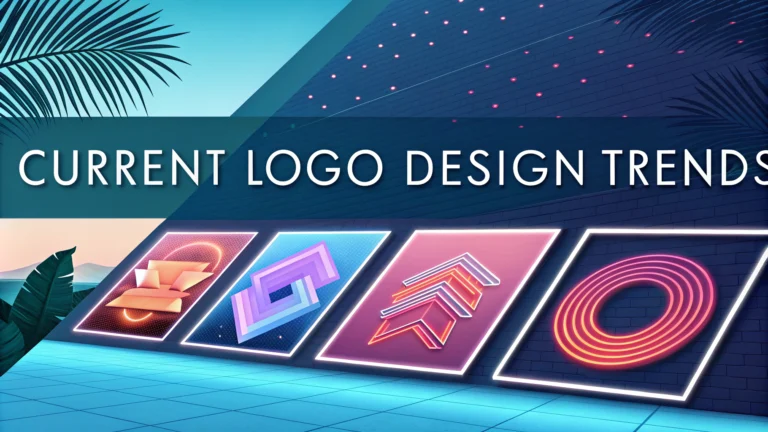Logo design trends shift rapidly as visual styles and consumer preferences evolve.
Minimalist Designs continue to dominate the market, with stripped-down logos that work across all platforms and sizes.
Current Notable Trends:
- Variable logos that adapt to different contexts
- Gradient color schemes making a strong comeback
- Geometric shapes with bold typography
- Hand-drawn elements adding personality
- 3D effects for depth and engagement
Responsive logos that change based on screen size are becoming standard practice for digital-first brands.
Color Trends for 2024:
- Muted pastels
- Deep, rich jewel tones
- Neon accents
- Earth-inspired palettes
Typography-based logos are seeing a surge, with custom letterforms creating unique brand identities.
Technical Considerations:
| Feature | Purpose |
|---|---|
| Scalability | Works at all sizes |
| Color variants | Adapts to different backgrounds |
| File formats | SVG for web, AI for print |
Animated logos are gaining traction for digital platforms, especially in social media and web applications.
Practical Tips:
- Test logos at multiple sizes before finalizing
- Create both horizontal and vertical versions
- Design in black and white first
- Consider cultural implications of symbols
Negative space designs continue to create clever, memorable logos that engage viewers.
AI-generated logos are emerging but haven’t replaced human creativity in crafting meaningful brand identities.
The most successful logos balance current trends with timeless design principles.
Contact professional logo designers through platforms like Behance or Dribbble for custom work.
Design Process Best Practices
Successful logo design requires a systematic approach combining research, conceptualization, and refinement stages.
Research Phase:
- Analyze competitor logos
- Study target audience preferences
- Review industry-specific design conventions
- Create mood boards for inspiration
Implementation Steps:
- Sketch multiple concepts
- Develop digital variations
- Present options to stakeholders
- Refine based on feedback
- Prepare final deliverables
Brand guidelines should accompany final logo files to ensure consistent usage across all platforms.
Future of Logo Design
Emerging technologies continue to shape how logos are created and implemented in digital spaces.
Upcoming Innovations:
- AR-compatible logo variations
- Smart logos that respond to user interaction
- Context-aware color adaptation
- Voice-activated brand elements
Conclusion
Effective logo design balances current trends with timeless principles while maintaining brand recognition and versatility.
Success in modern logo design requires:
- Understanding of digital requirements
- Flexibility in application
- Clear communication of brand values
- Forward-thinking implementation
Regular evaluation and subtle updates ensure logos remain relevant while retaining their core identity.
FAQs
- What are the dominant logo design trends for 2024?
Minimalist designs, animated logos, gradients 2.0, negative space techniques, eco-friendly themes, geometric shapes, abstract symbols, letter deconstruction, hand-drawn elements, and responsive logo variations. - Why are minimalist logos becoming more popular?
Minimalist logos are trending because they’re easily recognizable, versatile across different platforms, load quickly on digital devices, and communicate brand messages efficiently without visual clutter. - How are gradients being used differently in modern logo design?
Modern gradients are more sophisticated, using subtle color transitions, 3D effects, and mesmerizing color combinations. They’re particularly effective for digital applications and create depth while maintaining simplicity. - What makes a logo design “responsive”?
A responsive logo has multiple variations that adapt to different sizes and contexts while maintaining brand recognition. It includes simplified versions for smaller screens and detailed versions for larger formats. - How are eco-friendly themes being incorporated into logo design?
Eco-friendly logos use natural colors, organic shapes, leaf motifs, and sustainable imagery. They often incorporate elements that suggest environmental responsibility and sustainability. - What role does typography play in current logo trends?
Typography in logos is becoming more experimental, with custom fonts, broken letters, and deconstructed text. Bold, unique typefaces are being used to create distinctive brand identities. - How are geometric shapes being used innovatively in logo design?
Designers are combining basic geometric shapes in unexpected ways, using overlapping elements, creating 3D effects, and incorporating negative space to form complex yet clean designs. - What is the significance of animated logos in current design?
Animated logos add movement and interactivity to brand identities, making them more engaging for digital platforms. They can tell stories and create memorable brand experiences. - How important is color psychology in contemporary logo design?
Color psychology remains crucial, with brands choosing colors that evoke specific emotions and align with their values. Current trends show a preference for bold, vibrant colors and unexpected combinations. - What makes a logo design future-proof in today’s market?
Future-proof logos are simple, scalable, memorable, and work well across all platforms. They maintain their integrity in both digital and print formats while staying relevant to evolving design trends.








